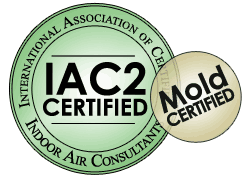Pyramid Home Inspections Call 951-536-1058 for a free price quote!

Pyramid Home Inspections
David Nasser 951-536-1058
Moreno Valley, CA 92553
Private Wells
Private Water Wells
If your family gets drinking water from a private well, do you know if your water is safe to drink? What health risks could you and your family face? Where can you go for help or advice? EPA regulates public water systems; it does not have the authority to regulate private drinking water wells. Approximately 15 percent of Americans rely on their own private drinking water supplies, and these supplies are not subject to EPA standards, although some state and local governments do set rules to protect users of these wells. Unlike public drinking water systems serving many people, they do not have experts regularly checking the waters source and its quality before it is sent to the tap. These households must take special precautions to ensure the protection and maintenance of their drinking water supplies.
Basic Information
There are three types of private drinking water wells: dug, driven, and drilled. Proper well construction and continued maintenance are keys to the safety of your water supply. Your state water-well contractor licensing agency, local health department, or local water system professional can provide information on well construction. The well should be located so rainwater flows away from it. Rainwater can pick up harmful bacteria and chemicals on the lands surface. If this water pools near your well, it can seep into it, potentially causing health problems. Water-well drillers and pump-well installers are listed in your local phone directory. The contractor should be bonded and insured. Make certain your ground water contractor is registered or licensed in your state, if required. If your state does not have a licensing/registration program contact the National Ground Water Association. They have a voluntary certification program for contractors. (In fact, some states use the Associations exams as their test for licensing.) For a list of certified contractors in your state contact the Association at (614) 898-7791 or (800) 551-7379. There is no cost for mailing or faxing the list to you.
To keep your well safe, you must be sure possible sources of contamination are not close by. Experts suggest the following distances as a minimum for protection farther is better:
- Septic Tanks, 50 feet
- Livestock yards, Silos, Septic Leach Fields, 50 feet
- Petroleum Tanks, Liquid-Tight Manure Storage and Fertilizer Storage and Handling, 100 feet
- Manure Stacks, 250 feet
Many homeowners tend to forget the value of good maintenance until problems reach crisis levels. That can be expensive. Its better to maintain your well, find problems early, and correct them to protect your wells performance. Keep up-to-date records of well installation and repairs plus pumping and water tests. Such records can help spot changes and possible problems with your water system. If you have problems, ask a local expert to check your well construction and maintenance records. He or she can see if your system is okay or needs work.
Protect your own well area. Be careful about storage and disposal of household and lawn care chemicals and wastes. Good farmers and gardeners minimize the use of fertilizers and pesticides. Take steps to reduce erosion and prevent surface water runoff. Regularly check underground storage tanks that hold home heating oil, diesel, or gasoline. Make sure your well is protected from the wastes of livestock, pets, and wildlife.
Dug Wells
Dug wells are holes in the ground dug by shovel or backhoe. Historically, a dug well was excavated below the groundwater table until incoming water exceeded the diggers bailing rate. The well was then lined (cased) with stones, brick, tile, or other material to prevent collapse. It was covered with a cap of wood, stone, or concrete. Since it is so difficult to dig beneath the ground water table, dug wells are not very deep. Typically, they are only 10 to 30 feet deep. Being so shallow, dug wells have the highest risk of becoming contaminated.To minimize the likelihood of contamination, your dug well should have certain features. These features help to prevent contaminants from traveling along the outside of the casing or through the casing and into the well.
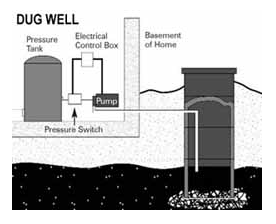
Dug Well Construction Features
- The well should be cased with a watertight material (for example, tongue-and-groove precast concrete) and a cement grout or bentoniteclay sealant poured along the outside of the casing to the top of the well.
- The well should be covered by a concrete curband cap that stands about a foot above the ground.
- The land surface around the well should be mounded so that surface water runs away from the well and is not allowed to pond around the outside of the wellhead.
- Ideally, the pump for your well should be inside your home or in a separate pump house, rather than in a pit next to the well.
Land activities around a dug well can also contaminate it. While dug wells have been used as a household water supply source for many years, most are relics of older homes, dug before drilling equipment was readily available or when drilling was considered too expensive. If you have a dug well on your property and are using it for drinking water, check to make sure it is properly covered and sealed. Another problem relating to the shallowness of a dug well is that it may go dry during a drought when the ground water table drops.
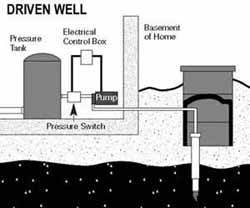
Driven Wells
Like dug wells, driven wells pull water from the water-saturated zone above the bedrock. Driven wells can be deeper than dug wells. They are typically 30 to 50 feet deep and are usually located in areas with thick sand and gravel deposits where the ground water table is within 15 feet of the grounds surface. In the proper geologic setting, driven wells can be easy and relatively inexpensive to install. Although deeper than dug wells, driven wells are still relatively shallow and have a moderate-to-high risk of contamination from nearby land activities.
Driven Well Construction Features
- Assembled lengths of two inches to three inches diameter metal pipes are driven into the ground. Ascreened well point located at the end of the pipe helps drive the pipe through the sand and gravel. The screen allows water to enter the well and filters out sediment.
- The pump for the well is in one of two places: on top ofthe well or in the house. An access pit is usually dug around the well down to the frost line and a water dis-charge pipe to the house is joined to the well pipe with a fitting.
- The well and pit are capped with the same kind of large-diameter concrete tile used for a dug well. The access pit may be cased with pre-cast concrete.
To minimize this risk, the well cover should be a tight-fitting concrete curb and cap with no cracks and should sit about a foot above the ground. Slope the ground away from the well so that surface water will not pond around the well. If there's a pit above the well, either to hold the pump or to access the fitting, you may also be able to pour a grout sealant along the outside of the well pipe. Protecting the water quality requires that you maintain proper well construction and monitor your activities around the well. It is also important to follow the same land use precautions around the driven well as described under dug wells.
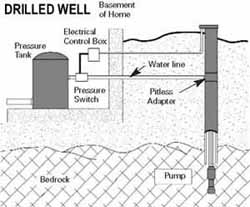
Drilled Wells
Drilled wells penetrate about 100-400 feet into the bedrock. Where you find bedrock at the surface, it is commonly called ledge. To serve as a water supply, a drilled well must intersect bedrock fractures containing ground water.
Drilled Well Construction Features
- The casing is usually metal or plastic pipe, six inches in diameter that extends into the bedrock to prevent shallow ground water from entering the well. By law, the casing has to extend at least 18 feet into the ground, with at least five feet extending into the bedrock. The casing should also extend a foot or two above the grounds surface. A sealant, such as cement grout or bentonite clay, should be poured along the outside of the casing to the top of the well. The well is capped to prevent surface water from entering the well.
- Submersible pumps, located near the bottom of the well, are most commonly used in drilled wells. Wells with a shallow water table may feature a jet pump located inside the home. Pumps require special wiring and electrical service. Well pumps should be installed and serviced by a qualified professional registered with your state.
- Most modern drilled wells incorporate a pitless adapter designed to provide a sanitary seal at the point where the discharge water line leaves the well to enter your home. The device attaches directly to the casing below the frost line and provides a watertight subsurface connection, protecting the well from frost and contamination.
- Older drilled wells may lack some of these sanitary features. The well pipe used was often 8-, 10- or 12- inches in diameter, and covered with a concrete well cap either at or below the grounds surface. This outmoded type of construction does not provide the same degree of protection from surface contamination. Also, older wells may not have a pitless adapter to provide a seal at the point of discharge from the well.
Hydrofracting A Drilled Well
Hydrofracting is a process that applies water or air under pressure into your well to open up existing fractures near your well and can even create new ones. Often this can increase the yield of your well. This process can be applied to new wells with insufficient yield and to improve the quantity of older wells.
How can I test the quality of my private drinking water supply?
Consider testing your well for pesticides, organic chemicals, and heavy metals before you use it for the first time. Test private water supplies annually for nitrate and coliform bacteria to detect contamination problems early. Test them more frequently if you suspect a problem. Be aware of activities in your watershed that may affect the water quality of your well, especially if you live in an unsewered area.
Human Health
The first step to protect your health and the health of your family is learning about what may pollute your source of drinking water. Potential contamination may occur naturally, or as a result of human activity.
What are Some Naturally Occurring Sources of Pollution?
- Microorganisms: Bacteria, viruses, parasites and other microorganisms are sometimes found in water. Shallow wells those with water close to ground level are at most risk. Runoff, or water flowing over the land surface, may pick up these pollutants from wildlife and soils. This is often the case after flooding. Some of these organisms can cause a variety of illnesses. Symptoms include nausea and diarrhea. These can occur shortly after drinking contaminated water. The effects could be short-term yet severe (similar to food poisoning) or might recur frequently or develop slowly over a long time.
- Radionuclides: Radionuclides are radioactive elements such as uranium and radium. They may be present in underlying rock and ground water
- Radon: Radon is a gas that is a natural product of the breakdown of uranium in the soil can also pose a threat. Radon is most dangerous when inhaled and contributes to lung cancer. Although soil is the primary source, using household water containing Radon contributes to elevated indoor Radon levels. Radon is less dangerous when consumed in water, but remains a risk to health.
- Nitrates and Nitrites: Although high nitrate levels are usually due to human activities (see below), they may be found naturally in ground water. They come from the breakdown of nitrogen compounds in the soil. Flowing ground water picks them up from the soil. Drinking large amounts of nitrates and nitrites is particularly threatening to infants (for example, when mixed in formula).
- Heavy Metals: Underground rocks and soils may contain arsenic, cadmium, chromium, lead, and selenium. However, these contaminants are not often found in household wells at dangerous levels from natural sources.
- Fluoride: Fluoride is helpful in dental health, so many water systems add small amounts to drinking water. However, excessive consumption of naturally occurring fluoride can damage bone tissue. High levels of fluoride occur naturally in some areas. It may discolor teeth, but this is not a health risk.
What Human Activities Can Pollute Ground Water?
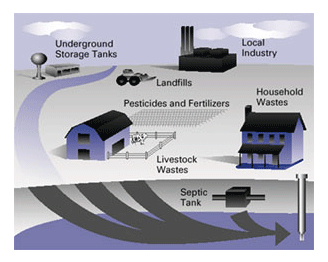
Septic tanks are designed to have a leach field around them an area where wastewater flows out of the tank. This wastewater can also move into the ground water.
Bacteria and Nitrates: These pollutants are found in human and animal wastes. Septic tanks can cause bacterial and nitrate pollution. So can large numbers of farm animals. Both septic systems and animal manures must be carefully managed to prevent pollution. Sanitary landfills and garbage dumps are also sources. Children and some adults are at extra risk when exposed to water-born bacteria. These include the elderly and people whose immune systems are weak due to AIDS or treatments for cancer. Fertilizers can add to nitrate problems. Nitrates cause a health threat in very young infants called blue baby syndrome. This condition disrupts oxygen flow in the blood.
- Concentrated Animal Feeding Operations (CAFOs): The number of CAFOs, often called factory farms, is growing. On these farms thousands of animals are raised in a small space. The large amounts of animal wastes/manures from these farms can threaten water supplies. Strict and careful manure management is needed to prevent pathogen and nutrient problems. Salts from high levels of manures can also pollute ground water.
- Heavy Metals: Activities such as mining and construction can release large amounts of heavy metals into nearby ground water sources. Some older fruit orchards may contain high levels of arsenic, once used as a pesticide. At high levels, these metals pose a health risk.
- Fertilizers and Pesticides: Farmers use fertilizers and pesticides to promote growth and reduce insect damage. These products are also used on golf courses and suburban lawns and gardens. The chemicals in these products may end up in ground water. Such pollution depends on the types and amounts of chemicals used and how they are applied. Local environmental conditions (soil types, seasonal snow and rainfall) also affect this pollution. Many fertilizers contain forms of nitrogen that can break down into harmful nitrates. This could add to other sources of nitrates mentioned above. Some underground agricultural drainage systems collect fertilizers and pesticides. This polluted water can pose problems to ground water and local streams and rivers. In addition, chemicals used to treat buildings and homes for termites or other pests may also pose a threat. Again, the possibility of problems depends on the amount and kind of chemicals. The types of soil and the amount of water moving through the soil also play a role.
-
Industrial Products and Wastes: Many harmful chemicals are used widely in local business and industry. These can become drinking water pollutants if not well managed. The most common sources of such problems are:
- Local Businesses: These include nearby factories, industrial plants, and even small businesses such as gas stations and dry cleaners. All handle a variety of hazardous chemicals that need careful management. Spills and improper disposal of these chemicals or of industrial wastes can threaten ground water supplies.
- Leaking Underground Tanks & Piping: Petroleum products, chemicals, and wastes stored in underground storage tanks and pipes may end up in the ground water. Tanks and piping leak if they are constructed or installed improperly. Steel tanks and piping corrode with age. Tanks are often found on farms. The possibility of leaking tanks is great on old, abandoned farm sites. Farm tanks are exempt from the EPA rules for petroleum and chemical tanks.
- Landfills and Waste Dumps: Modern landfills are designed to contain any leaking liquids. But floods can carry them over the barriers. Older dumpsites may have a wide variety of pollutants that can seep into ground water.
- Household Wastes: Improper disposal of many common products can pollute ground water. These include cleaning solvents, used motor oil, paints, and paint thinners. Even soaps and detergents can harm drinking water. These are often a problem from faulty septic tanks and septic leaching fields.
-
Lead & Copper: Household plumbing materials are the most common source of lead and copper in home drinking water. Corrosive water may cause metals in pipes or soldered joints to leach into your tap water. Your waters acidity or alkalinity (often measured as pH) greatly affects corrosion. Temperature and mineral content also affect how corrosive it is. They are often used in pipes, solder, or plumbing fixtures. Lead can cause serious damage to the brain, kidneys, nervous system, and red blood cells. The age of plumbing materials in particular, copper pipes soldered with lead is also important. Even in relatively low amounts these metals can be harmful. EPA rules under the Safe Drinking Water Act limit lead in drinking water to 15 parts per billion. Since 1988 the Act only allows lead free pipe, solder, and flux in drinking water systems. The law covers both new installations and repairs of plumbing.
What You Can Do...
Private, individual wells are the responsibility of the homeowner. To help protect your well, here are some steps you can take:
Have your water tested periodically. It is recommended that water be tested every year for total coliform bacteria, nitrates, total dissolved solids, and pH levels. If you suspect other contaminants, test for those. Always use a state certified laboratory that conducts drinking water tests. Since these can be expensive, spend some time identifying potential problems.
Testing more than once a year may be warranted in special situations:
- someone in your household is pregnant or nursing
- there are unexplained illnesses in the family
- your neighbors find a dangerous contaminant in their water
- you note a change in water taste, odor, color or clarity
- there is a spill of chemicals or fuels into or near your well
- when you replace or repair any part of your well system
Identify potential problems as the first step to safeguarding your drinking water. The best way to start is to consult a local expert, someone that knows your area, such as the local health department, agricultural extension agent, a nearby public water system, or a geologist at a local university.
Be aware of your surroundings. As you drive around your community, take note of new construction. Check the local newspaper for articles about new construction in your area.
Check the paper or call your local planning or zoning commission for announcements about hearings or zoning appeals on development or industrial projects that could possibly affect your water.
Attend these hearings, ask questions about how your water source is being protected, and don't be satisfied with general answers. Make statements like "If you build this landfill, (just an example) what will you do to ensure that my water will be protected." See how quickly they answer and provide specifics about what plans have been made to specifically address that issue.
Identify Potential Problem Sources
To start your search for potential problems, begin close to home. Do a survey around your well:
- is there livestock nearby?
- are pesticides being used on nearby agricultural crops or nurseries?
- do you use lawn fertilizers near the well?
- is your well "downstream" from your own or a neighbor's septic system?
- is your well located near a road that is frequently salted or sprayed with de-icers during winter months?
- do you or your neighbors dispose of household wastes or used motor oil in the backyard, even in small amounts?
If any of these items apply, it may be best to have your water tested and talk to your local public health department or agricultural extension agent to find way to change some of the practices which can affect your private well.
In addition to the immediate area around your well, you should be aware of other possible sources of contamination that may already be part of your community or may be moving into your area. Attend any local planning or appeal hearings to find out more about the construction of facilities that may pollute your drinking water. Ask to see the environmental impact statement on the project. See if underground drinking water sources has been addressed. If not, ask why.
Here's what our clients say about us
"David's work is the best! Always gets the job done right away!! Would definitely recommend him to all my clients"
Sunny Wang - Etopbroker
I know homes in Corona, California. Give me a call at 951-536-1058 to discuss your home inspection today!
Need a website for your business?


